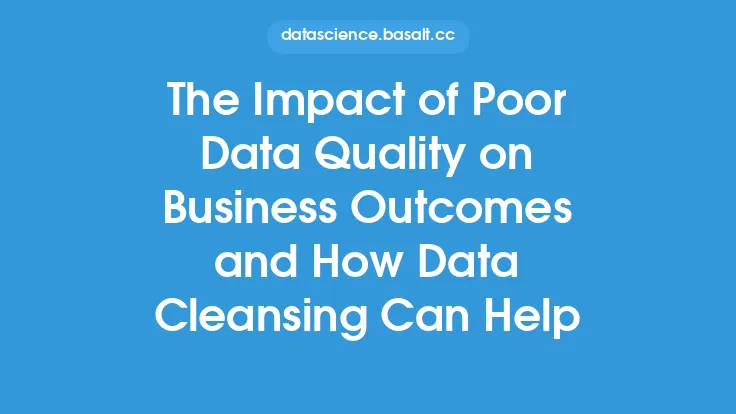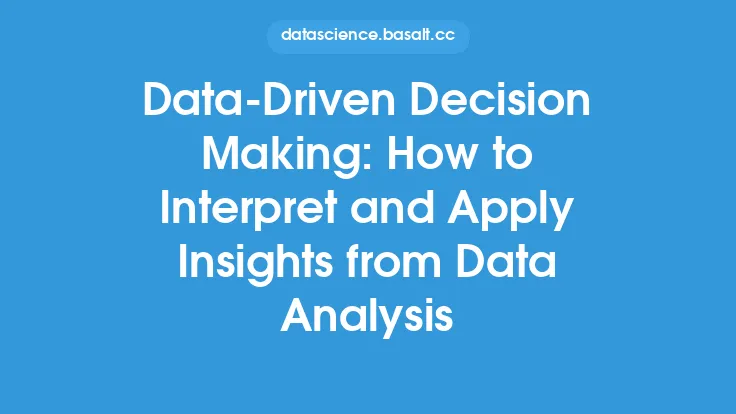Data cleansing is a critical step in the data science workflow, particularly when it comes to predictive modeling and machine learning. The quality of the data used to train and test models has a direct impact on their performance and accuracy. In this article, we will explore the importance of data cleansing in improving predictive modeling and machine learning outcomes, and provide guidance on how to leverage data cleansing techniques to achieve better results.
Introduction to Predictive Modeling and Machine Learning
Predictive modeling and machine learning are powerful tools used to analyze and interpret complex data sets. These techniques enable organizations to make informed decisions, identify trends, and predict future outcomes. However, the success of these models depends on the quality of the data used to train and test them. Poor data quality can lead to biased models, incorrect predictions, and poor decision-making. Data cleansing is essential to ensure that the data used for predictive modeling and machine learning is accurate, complete, and consistent.
The Impact of Data Quality on Predictive Modeling and Machine Learning
Data quality issues can have a significant impact on predictive modeling and machine learning outcomes. Some common data quality issues that can affect model performance include:
- Missing or null values: Missing values can lead to biased models and incorrect predictions.
- Duplicate or redundant data: Duplicate data can lead to overfitting and poor model performance.
- Inconsistent or erroneous data: Inconsistent or erroneous data can lead to incorrect predictions and poor decision-making.
- Outliers or anomalies: Outliers or anomalies can affect model performance and lead to incorrect predictions.
Data cleansing techniques can help to identify and address these data quality issues, ensuring that the data used for predictive modeling and machine learning is of high quality.
Data Cleansing Techniques for Predictive Modeling and Machine Learning
There are several data cleansing techniques that can be used to improve predictive modeling and machine learning outcomes. Some common techniques include:
- Data profiling: Data profiling involves analyzing the data to identify patterns, trends, and correlations.
- Data validation: Data validation involves checking the data for errors, inconsistencies, and missing values.
- Data normalization: Data normalization involves transforming the data into a consistent format to prevent errors and inconsistencies.
- Data transformation: Data transformation involves converting the data into a format that is suitable for modeling and analysis.
- Handling missing values: Handling missing values involves imputing or replacing missing values with meaningful values.
- Removing duplicates: Removing duplicates involves deleting duplicate or redundant data to prevent overfitting.
- Outlier detection: Outlier detection involves identifying and addressing outliers or anomalies in the data.
Best Practices for Data Cleansing in Predictive Modeling and Machine Learning
To get the most out of data cleansing in predictive modeling and machine learning, it's essential to follow best practices. Some best practices include:
- Developing a data cleansing strategy: Developing a data cleansing strategy involves identifying the data quality issues that need to be addressed and selecting the appropriate data cleansing techniques.
- Using data visualization: Using data visualization involves using plots and charts to understand the data and identify patterns, trends, and correlations.
- Using data quality metrics: Using data quality metrics involves tracking and measuring data quality issues to ensure that the data cleansing techniques are effective.
- Continuously monitoring data quality: Continuously monitoring data quality involves regularly checking the data for errors, inconsistencies, and missing values to ensure that the data remains accurate and complete.
- Documenting data cleansing activities: Documenting data cleansing activities involves keeping a record of the data cleansing techniques used, the data quality issues addressed, and the results achieved.
Advanced Data Cleansing Techniques for Predictive Modeling and Machine Learning
In addition to the common data cleansing techniques, there are several advanced techniques that can be used to improve predictive modeling and machine learning outcomes. Some advanced techniques include:
- Using machine learning algorithms for data cleansing: Using machine learning algorithms for data cleansing involves using algorithms such as decision trees, random forests, and neural networks to identify and address data quality issues.
- Using deep learning techniques for data cleansing: Using deep learning techniques for data cleansing involves using techniques such as autoencoders and generative adversarial networks to identify and address data quality issues.
- Using natural language processing for data cleansing: Using natural language processing for data cleansing involves using techniques such as text preprocessing and sentiment analysis to identify and address data quality issues in text data.
Conclusion
Data cleansing is a critical step in the data science workflow, particularly when it comes to predictive modeling and machine learning. By leveraging data cleansing techniques, organizations can improve the accuracy and performance of their models, leading to better decision-making and outcomes. By following best practices and using advanced data cleansing techniques, organizations can ensure that their data is of high quality and suitable for predictive modeling and machine learning.





